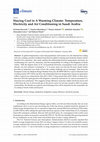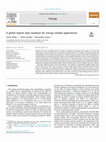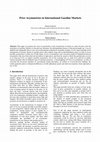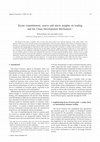Papers by Alessandro LANZA

Climate
As global temperatures warm and populations and incomes rise, the demand for cooling will soar, c... more As global temperatures warm and populations and incomes rise, the demand for cooling will soar, creating a positive feedback loop between global warming and electricity-related carbon dioxide (CO2) emissions. This study explores the relationship between temperature, electricity, air conditioning (AC) and CO2 emissions, and the sustainability of cooling in the Kingdom of Saudi Arabia. With the highest share of AC in household electricity consumption in the world and its already very hot summers warming by 3 °C in many areas over the last 40 years, Saudi Arabia provides an important case study of how the cooling challenge can be managed. Data from the European Centre for Medium-Range Weather Forecasts (ECMWF ERA5) is used to illustrate local warming trends (1979–2018) and show the relationship between temperature and power generation within a typical year using hourly data (2011–2015). Using annual data (2010–2018), we then show that since 2016 the rapid growth in the Kingdom’s electr...

SSRN Electronic Journal, 2000
Weather can have a profound effect on energy consumption particularly with respect to hot and col... more Weather can have a profound effect on energy consumption particularly with respect to hot and cold temperatures, driving residential and commercial energy demand. The cooling and heating degree day methodology has been often been regarded as a reliable means to account for this effect for purposes of normalization and econometric analysis. However, when applied within the context of international crosscountry comparison, this methodology suffers from two majors limitations: the lack of an appropriate international database that encompasses degree days at a functional spatial and temporal aggregation using various reference temperatures, and second, the existing methodologies only account for the effect of temperature and ignore the potential effect of other climatic factors such as humidity and solar radiation. This paper addresses these issues by presenting a new database of population-weighted degree days for 147 countries for 1948e2013 at various reference temperatures based on multiple thermal comfort indices. The database was mainly developed to compare the influence of weather on energy use across countries. This is important for policy because it defines the playing field for potential intervention to improve energy efficiency and productivity. It also puts countries on equal footing when it comes to participating in international energy and environmental negotiations.
Input-Output Analysis, 1988

L’entrata in vigore del Protocollo di Kyoto è un segnale concreto della volontà e dell’impeg... more L’entrata in vigore del Protocollo di Kyoto è un segnale concreto della volontà e dell’impegno della Comunità Internazionale ad attuare delle politiche di controllo dei cambiamenti climatici. Il clima sta cambiando e, nonostante l’incertezza sui numeri, c’è sempre maggior consenso sul contributo delle attività umane ai cambiamenti in atto. L’aumento nella temperatura e nella frequenza di eventi climatici estremi su scala globale infatti avviene a fronte di una crescita economica senza precedenti, che oggi coinvolge il mondo industrializzato, le economie emergenti dell’est europeo ed alcuni grossi paesi del sud del mondo, principalmente Cina e India, caratterizzati da una altrettanto preoccupante crescita demografica. Gli scenari tendenziali di crescita delle emissioni prospettati dai modelli macro-economici sono allarmanti, e invocano il disegno e l’implementazione di politiche globali per la mitigazione e l’adattamento dei cambiamenti climatici, fondate sui princi...

The Climate Change debate has drawn attention to the problem of greenhouse gases emissions into t... more The Climate Change debate has drawn attention to the problem of greenhouse gases emissions into the atmosphere. One of the most important issues in the policy debate is the role that should be played by developing countries in joining the commitment of developed countries to reduce GHG emissions, and particularly CO 2 emissions. This debate calls into play the relationship between energy consumption, CO 2 emissions and economic development. In this paper we use a panel data model for 110 world countries to estimate the relationship between CO 2 emissions and GDP and to produce emission forecast. The paper contains three major results: (i) the empirical relationship between carbon dioxide and income is well described by non linear Gamma and Weibull specifications as opposed to more usual linear and log-linear functional forms; (ii) our single equation reduced form model is comparable in terms of forecasted emissions with other more complex, less data driven models; (iii) despite the decreasing marginal propensity to pollute, our forecasts show that future global emissions will rise. The average world growth of CO 2 emissions between 2000 and 2020 is about 2.2% per year, while that of Non Annex 1 countries is posted at 3.3% per year.
The number of studies seeking to empirically characterize the reduced-form relationship between a... more The number of studies seeking to empirically characterize the reduced-form relationship between a country economic growth and the quantity of pollutants produced in the process has recently increased significantly. In several cases researchers have found evidence pointing to an inverted-U “environmental Kuznets ” curve. In the case of a major greenhouse gas, CO2, however, the evidence is at best mixed. This paper attempts to shed further light on this issue by using a newly developed dataset on emissions and by employing a new highly flexible functional form. This draft: April 2001.
This paper presents an estimation of the cost of reducing CO2 emissions as agreed in Kyoto by Ann... more This paper presents an estimation of the cost of reducing CO2 emissions as agreed in Kyoto by Annex I countries. Unlike most of the existing literature, this paper focuses on European Union countries abatement costs and, using a simple model, estimates the role of each EU country within a EU market as well as an Annex 1 market. As a major result, marginal (and total) abatement costs for each EU country (as well as the EU total cost) are presented. Some conclusions on the redistribution of income among market participants related to the trading system are also shown. Corresponding author: Francesco Pauli- ENEA – Funzione studi Lungo Tevere Thaon di Revel, 76

This paper re-examines the issue of asymmetries in the transmission of shocks to crude oil prices... more This paper re-examines the issue of asymmetries in the transmission of shocks to crude oil prices onto the retail price of gasoline. Relative to the previous literature, the distinguishing features of the present paper are: i) use of updated and comparable data to carry out an international comparison of gasoline markets; ii) two-stage modeling of the transmission of oil price shocks to gasoline prices (first refinery stage and second distribution stage), in order to assess possible asymmetries at either one or both stages; iii) use of asymmetric error correction models to distinguish between asymmetries that arise from short-run deviations in input prices and from the speed at which the gasoline price reverts to its long-run level; iv) explicit, possibly asymmetric, role of the exchange rate, as crude oil is paid for in dollars whereas gasoline sells for different sums of national currencies; v) bootstrapping of F tests of asymmetries, in order to overcome the low-power problem of ...

Having grown faster than world GDP since the 1950s, international tourism is today one of the mos... more Having grown faster than world GDP since the 1950s, international tourism is today one of the most important tradable sectors, with expenditure on tourist goods and services representing some 8% of total world export receipts and 5% of world GDP. Staring from a broad perspective, two main facts could be pointed out: a) countries specialised in the tourism sector have experienced in the recent past a good economic performance and b) they have a (relatively) small dimension. This paper examines these facts considering with particular attention the dimension point of view. We use a two-sector endogenous growth model to define the conditions required for small countries with a relative large endowment of natural resource to specialise in tourism and to enter the faster growth path. A model based on the size of the natural resource suitable for tourism development is presented and discussed.

The purpose of this paper is twofold. First, we raise some issues related to the expected dimensi... more The purpose of this paper is twofold. First, we raise some issues related to the expected dimension of the carbon market. This analysis is based on a survey of model results on the implementation of the Kyoto goal with and without reliance on emissions trading. In particular, we consider both the emissions and the financial implications associated with different trading scenarios. Transfers related to international GHG trading might be equivalent to a 400% increase in foreign direct investment to countries with economies in transition. A closer look at the GHG reductions expected from the developing world also suggests that global models may be overly optimistic in their assessment of the contribution of flexibility mechanisms in meeting the Kyoto emission goals. OECD countries may need to rely more on domestic policies to reduce their emissions than what has so far been projected by global models. Second, we use a simple microeconomic model to test the potential contribution of typical power generation technologies in the context of the Clean Development Mechanism. Projects that are defined as additional in terms of the environment but already profitable can bring about significant results at a relatively low price of certified emission reductions. To assume that the contribution of the CDM will come close to what is projected by global models (both for prices and quantities) is to assume that such projects could be credited under the CDM.

SSRN Electronic Journal, 2000
This paper estimates the dynamic conditional correlations in the returns on WTI oil onemonth forw... more This paper estimates the dynamic conditional correlations in the returns on WTI oil onemonth forward prices, and one-, three-, six-, and twelve-month futures prices, using recently developed multivariate conditional volatility models. The dynamic correlations enable a determination of whether the forward and various futures returns are substitutes or complements, which are crucial for deciding whether or not to hedge against unforeseen circumstances. The models are estimated using daily data on WTI oil forward and futures prices, and their associated returns, from 3 January 1985 to 16 January 2004. At the univariate level, the estimates are statistically significant, with the occasional asymmetric effect in which negative shocks have a greater impact on volatility than positive shocks. In all cases, both the short-and long-run persistence of shocks are statistically significant. Among the five returns, there are ten conditional correlations, with the highest estimate of constant conditional correlation being 0.975 between the volatilities of the three-month and six-month futures returns, and the lowest being 0.656 between the volatilities of the forward and twelve-month futures returns. The dynamic conditional correlations can vary dramatically, being negative in four of ten cases and being close to zero in another five cases. Only in the case of the dynamic volatilities of the three-month and six-month futures returns is the range of variation relatively narrow, namely (0.832, 0.996). Thus, in general, the dynamic volatilities in the returns in the WTI oil forward and future prices can be either independent or interdependent over time.

SSRN Electronic Journal, 2000
Specializing in tourism is an option available to a number of less developed countries and region... more Specializing in tourism is an option available to a number of less developed countries and regions. But is it a good option? To answer this question, we have compared the relative growth performance of 14 "tourism countries" within a sample of 143 countries, observed during the period 1980-95. Using standard OLS cross-country growth regressions, we have documented that the tourism countries grow significantly faster than all the other sub-groups considered in our analysis (OECD, Oil, LDC, Small). Moreover, we have shown that the reason why they are growing faster is neither that they are poorer than the average; nor that they have particularly high saving/investment propensities; nor that they are very open to trade. In other words, the positive performance of the tourism countries is not significantly accounted for by the traditional growth factors of the Mankiw, Romer and Weil type of models. Tourism specialization appears to be an independent determinant. A corollary of our findings is that the role played by the tourism sector should not be ignored by the debate about whether smallness is harmful for growth (e.g. Easterly and Kraay , who conclude that there is no growth disadvantage in smallness). Half of the thirty countries classified as microstates in this literature are heavily dependent on tourism. Once this distinction is adopted, it is easy to see that the small tourism countries perform much better than the remaining small countries. In our findings, smallness per se can be bad for growth, while the opposite is true when smallness goes together with a specialization in tourism.
SSRN Electronic Journal, 2000
The number of studies seeking to empirically characterize the reduced-form relationship between a... more The number of studies seeking to empirically characterize the reduced-form relationship between a country economic growth and the quantity of pollutants produced in the process has recently increased significantly. In several cases researchers have found evidence pointing to an inverted-U "environmental Kuznets" curve. In the case of a major greenhouse gas, CO 2 , however, the evidence is at best mixed. This paper attempts to shed further light on this issue by using a newly developed dataset on emissions and by employing a new highly flexible functional form.
SSRN Electronic Journal, 2000
We analyze the empirical relationship between growth, country size and tourism specialization by ... more We analyze the empirical relationship between growth, country size and tourism specialization by using a dataset covering the period 1980-2003. We find that tourism countries grow significantly faster than all the other sub-groups considered in our analysis. Tourism appears to be an independent determining factor for growth, and the reason for that is neither because they are poorer than the average, nor because they are very open to trade. Another finding of our paper is that small states are fast-growing only when they are highly specialized in tourism. In contrast with some previous conclusions in the literature, smallness per se is not good for growth. .

Uploads
Papers by Alessandro LANZA